Emergency order. Defeat the Metroid of Planet Zebes. Destroy the Mother Brain.
–Galaxy Federal Police M510
One of my favorite games for the NES is the non-linear, action/adventure game Metroid. In revisiting the game, I realized several important things. First, not only did I never finish Metroid back in the day, I didn’t get very far into the game at all! At best, I had gotten to one of the bosses, but that, of course, is nowhere near the end of the game. The game was indeed hard, but it’s interesting that I did fall in love with it nevertheless.

In replaying the game, I actually managed to win. Of course, I cheated. I used maps, walkthroughs and most importantly, I utilized my emulator’s ability to create saved games. That last one, more than anything else, made the game about a hundred times less frustrating to play. I recognize that the hardware limitations of the NES made it difficult to allow saved games (this game was released before the batteries that allowed saves on newer games), but Metroid was incredibly punitive. It often seems like the game is constructed to waste time, something that would infuriate me in a game today (and indeed, I was not a fan of Metroid III). So the ability to save the game at any time made things a lot easier. I know this isn’t a “fair” way to play the game, and I’m sure purists are leaving my site in disgust, but I have to say, the game was a lot of fun.
So why do I love this game? I think a lot of it has to do with the atmosphere of the game. There’s not much of a story, but it’s clear what you’re supposed to do. The music is evocative, the character and monster designs are fantastic for an 8 bit game, and the gameworld is sprawling, open and varied. Again, there’s no real narrative in the game, so when you see various designs, you’re forced to come up with explanations of your own. For instance, whenever you find a power-up, it’s being held by some bird-like statue. Why? Who knows? When entering various boss’ lairs, there is a weird alien creature’s head that is evocative without being too cheesy.
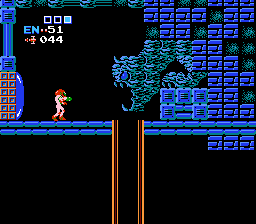
Samus entering Kraid’s lair
This is an action game with platforming elements, but the primary gameplay element is actually exploration. One of the most shocking and subversive things this game did was that it forced you to go left. Indeed, in order to start exploring past the first screen, you need to go left first and gain a power-up. This might seem trivial or silly today, but it was revolutionary back then. The notion of going left-to-right is so ingrained in our consciousness from reading (and other video games), that the concept that we not only could go left, but that we were required to do so, was amazing. The game was also one of the first to use backtracking as a key element. In addition, the game is filled with secrets, hidden barriers, and tricks. Furthermore, these secret barriers were necessary in order to win the game, making the process of exploration that much more fun. Despite the punishing difficulty of the game, the focus on probing captivated me, even when I was younger (and now that I can mitigate the difficulty with saved games, the focus on probing and exploration is that much more rewarding).
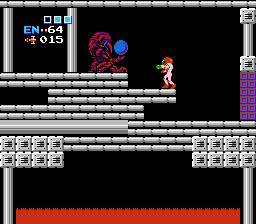
Samus finds a new weapon
Like other games of the era, such as the Zelda series, Metroid required you to collect various items, weapons, and abilities in order to strengthen your character. And as you gained various powers, additional areas of the map became accessible. The sprawling, open-world design of the world was quite alluring (I’m also a big fan of precursors like Pitfall II and successors like GTA III) and again, the game’s atmosphere really draws you in. It’s funny, but part of the allure is the solitary nature of your character. You are literally the only person on the planet. A planet infested with all sorts of nasty creatures and lava pits and all sorts of other crazy obstacles. The design works well, emphasizing the solitude and desperation, yet somehow retaining a fun experience.
One of the things that really struck me upon replaying this game was just how excellent the platforming elements of this game are. Many platformers of the era had floaty, unresponsive controls (I’m looking at you, Castlevania!) which at the time were considered part of the challenge. Not so here. The control and freedom of movement of Samus was quite liberating compared to other games. You could even control a jump while in mid-air. And later powerups like the Super Jump and most importantly, the Screw Attack (one of the best video game weapons ever), made the experience that much better.
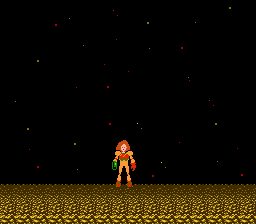
Samus is a woman!
One of the things I never realized about Metroid (perhaps because I never finished it back in the day!) was that there actually multiple endings to the game, based on how long it took you to complete the game. Three of the endings revealed something that was pretty shocking at the time: the character you had been playing for the whole game with the awesome power armor? It was a woman! The version I got had her take off her helmet to reveal her long hair. Other versions included her taking off all her armor to reveal a leotard or even a bikini. Then there are the versions where you took too long to complete the game. Those had her keep on her suit (in effect not revealing her identity) and in the “worst” ending, she turns her back to you and covers her face in shame. The fact that the game had different endings based on how quickly you finished started a trend of people doing Metroid Speed Runs, attempting to win the game as quick as humanly possible (The best time right now is just over 18 minutes, which is pretty insane).
It’s interesting that the original game has so many elements that I don’t especially like in games, but it makes up for any shortcomings with exceptional visual, sound, and gameplay design. It definitely isn’t my all-time favorite game for the NES, but it’s up there with my favorites .
More screenshots and comments below the fold…
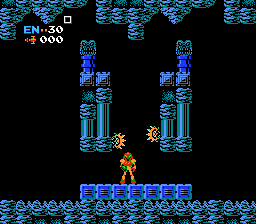
This is where you start in Metroid, and I have to admit to a nostalgic chill when I first heard the famous Metroid fanfare playing.

This is one of the bosses, Kraid. The game also has a “fake” version of Kraid, presumably to trick you into thinking you defeated Kraid, then getting to the end of the game and realizing that something is very wrong. These game designers for Metroid, they were very cruel.
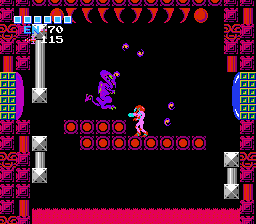
This is the other boss, named Ridley. To be honest, I’m not sure which boss you’re supposed to defeat first (which is a pretty cool consequence of an open ended game like this), but Ridley is extremely easy to defeat.
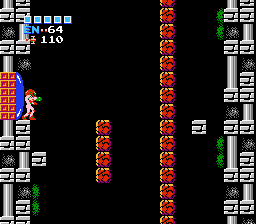
Frustration, thy name is this screen (and I’ve already gotten pas the really hard part).
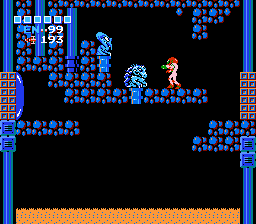
One of the consequences of having a somewhat open world like this is that you can reach screens very early in the game that will not become important until the very end. This screen is very tantalizing, and it’s really the only in-game hint that there are two bosses you need to defeat before continuing to the last area in the game (they’re the two statues on the page – they’re Kraid and Ridley – and later in the game, shooting them both opens a bridge across the lava).
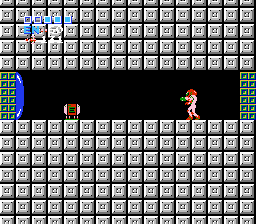
Once again, these Metroid designers were very sneaky. Any time you run into a situation like this where something very desirable (like the energy tank) is seemingly easy to access, you know something’s up. It turns out that there’s an invisible pit just before you reach the energy tank in this screenshot. To get the tank, you have to then make a looooong trek through a bunch of enemy infested screens in order to get back up to the tank.
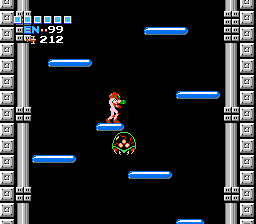
The little jellyfish thing below Samus there is one of the titular Metroids. These things are huge pains in the ass. You don’t get to see any of them until the very end of the game though, and by then you should be pretty adept at using the ice gun… Thank goodness for saved games though.

This is the final boss in the game, Mother Brain, and she is damn hard to beat. It’s not so much her that’s tough as those stupid fire ring things and gun turrets that surround her. Also, if you fall into the lava in front of her, it’s very hard to get back out. Man, the thought of doing this without saved games makes me queasy. Amazingly, once you defeat Mother Brain, the game isn’t over. You’re given 999 seconds to escape through a vertical shaft that requires some very nifty jumps. But that doesn’t stop you for long, and then you get the ending:
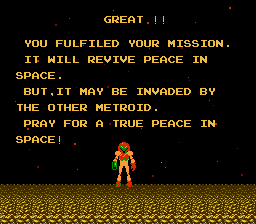
I have to admit, for an ending to a game this difficult, this is actually quite lame. If it wasn’t for the reveal of Samus’ gender a little bit later, this qould be a horrible ending. As it is, it works really well.
Well, that finishes off Metroid. It’s probably not my favorite game, but I probably won’t have such a detailed recap for other games. It was the fact that I actually managed to win the replay of this game that allowed me to take all these screenshots. I haven’t played through as much of most of the other games I’ll cover, and there are too many games to go over in this much detail… But I’ll do my best. Stay tuned for the Zelda games!